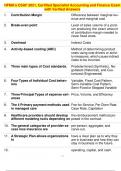HFMA's CSAF 2021, Certified Specialist Accounting and Finance Exam
with Verified Answers
1. Contribution Margin Difference between marginal rev-
enue and marginal cost.
2. Break-even point Level of sales volume of a prod-
uct producing the exact amount
of contribution margin needed to
cover fixed costs.
3. Overhead Indirect Costs
4. Activity-based costing (ABC) Method of determining product
costs using cost drivers or activi-
ty measures, which cause indirect
costs to be incurred.
5. Three main types of Cost standards. Predetermined (Synthetic), Ne-
gotiated (Historical), and Cus-
tomized (Engineered)
6. Four Types of Individual Cost behav- Variable, Fixed Cost Pattern,
iors Semi-Variable Cost Pattern,
Semi-Fixed or Stepped Variable
7. Three Principal Types of expense vari- Price, Volume, and Efficiency
ances
8. The 4 Primary payment methods used Fee-for-Service, Per Diem Rate,
in managed care Case Rate, Capitation
9. Healthcare providers should develop the reimbursement method pro-
different modeling tools depending on posed in the contract
10. The general categories of provider ex- per-person, aggregate, and
cess loss insurance are carve-out.
11. A Strategic Plan allows organizations have a clear plan as to why they
to are in business and how they can
stay in business in the future.
12. operating, capital, and cash.
,HFMA's CSAF 2021, Certified Specialist Accounting and Finance Exam
with Verified Answers
The main types of control budgets in-
clude
13. A budgeting process develops as- Admissions, ALOS, Expense per
sumptions for the following: visit, Inflation on expense, FTE
per visit, Productivity on FTE per
visit, Labor cost per FTE, Net Rev
per visit
14. Operating budget's statistical factors Historical statistics, Historical re-
include lationship of department volume,
anticipated effects of new pro-
grams, clinical practice patters,
covered lives in global payment
risk programs, changes in regula-
tory environment, technical devel-
opments, process improvements,
marketing efforts, demographic
trends
15. The primary purpose of measuring for management to determine if
productivity is resources are being used effi-
ciently
16. Budget types include fixed and flexible
17. The four budget variances used to ex- Volume, rate (charged), price (of
plain by cause are a supply), and efficiency (cost per
procedure).
18. Three common Capital Evaluation Payback, Net Present Value
techniques Method, Return on Investment
19. Users of ratio analysis Board of Directors, Management,
Health Systems Agencies, Credi-
tors, Employee Unions, Rate Reg-
ulators
20. The categories of ratios used
,HFMA's CSAF 2021, Certified Specialist Accounting and Finance Exam
with Verified Answers
Profitability Ratios, Liquidity Ra-
tios, Activity Ratios, Capital Struc-
ture Ratios
21. Two common types of long-term debt Revenue bonds and General
Obligation Bonds
22. Undertake debt restructuring by either Take advantage of lower interest
retiring or reacquiring existing debt for rates, change collateral restric-
4 reasons tions, allow acquisition of other
assets, better fit debt service re-
quriements
23. Healthcare bond issues place legal the borrower intended to protect
obligations on the lender against default by the
borrower.
24. In order to use the discounted cash you need to know the payment
flow method flow or payment pattern and the
interest rate
25. Every capital investment proposal re- Cash Outflow, Cash Inflow, Eco-
quires 4 quantifiable factors nomic Life, Opportunity Cost of
funds
26. Three significant Investment valuation Discounted cash flow method, Re-
methods placement cost method, Market
comparison
27. Two types of equity financing Internal and External
28. In a capital lease, all of the benefits and get transferred to the lessee. The
risks of owner except title or ending lessor recovers full price and inter-
(salvage value) est during the lease.
29. An operating lease is when the hospital is liable for the
leasing cost; renewal options are
determined by the fair market val-
ue
, HFMA's CSAF 2021, Certified Specialist Accounting and Finance Exam
with Verified Answers
30. Advantages of leasing working capital is conserved, bud-
getary control, tax benefits may be
realized, project may be financed
100%, lessee has greater flexibili-
ty in replacing equipment
31. Disadvantages of leasing Cost of extending the lease may
be more than the actual purchase
price, Interest costs are higher
than debt, third parties will recog-
nize a full lease payment as al-
lowable only if a true operating
lease, the leasing company fre-
quently passes the cost of proper-
ty tax to the lessors
32. When issuing a rating on a specific Provisions or structure of the fi-
organization, a rating agency will com- nancing, competitive environment
monly consider the following and market position, medical staff
characteristics, management ca-
pability, financial
33. Methods of a Cash budget: Cash receipts and disbursements
Method, Adjusted Net Income
Method, Working Capital Differen-
tial Method
34. Primary purposes of a cash budget: Identify cash requirements and
sources for a certain period of
time, control the flow of cash funds
35. Healthcare organizations use commer- Controlled Disbursement Ac-
cial banking services for: count, Depository Account, Con-
centration Account and Zero Bal-
ance Account, Sweep Account
36. The components incorporated in a Ability of the organization to man-
cash budget: age overall revenue cycle, projec-
tion of costs, variability in activities
that impact both revenues and ex-




